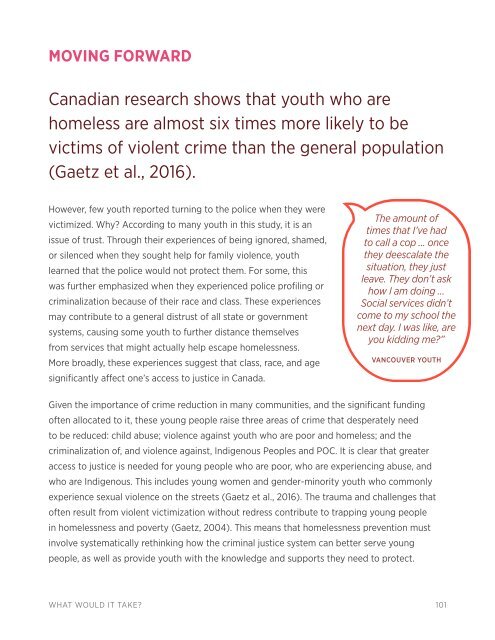COH-AWH-What_Would_it_Take
Create successful ePaper yourself
Turn your PDF publications into a flip-book with our unique Google optimized e-Paper software.
MOVING FORWARD<br />
Canadian research shows that youth who are<br />
homeless are almost six times more likely to be<br />
victims of violent crime than the general population<br />
(Gaetz et al., 2016).<br />
However, few youth reported turning to the police when they were<br />
victimized. Why? According to many youth in this study, <strong>it</strong> is an<br />
issue of trust. Through their experiences of being ignored, shamed,<br />
or silenced when they sought help for family violence, youth<br />
learned that the police would not protect them. For some, this<br />
was further emphasized when they experienced police profiling or<br />
criminalization because of their race and class. These experiences<br />
may contribute to a general distrust of all state or government<br />
systems, causing some youth to further distance themselves<br />
from services that might actually help escape homelessness.<br />
More broadly, these experiences suggest that class, race, and age<br />
significantly affect one’s access to justice in Canada.<br />
The amount of<br />
times that I’ve had<br />
to call a cop … once<br />
they deescalate the<br />
s<strong>it</strong>uation, they just<br />
leave. They don’t ask<br />
how I am doing …<br />
Social services didn’t<br />
come to my school the<br />
next day. I was like, are<br />
you kidding me?”<br />
VANCOUVER YOUTH<br />
Given the importance of crime reduction in many commun<strong>it</strong>ies, and the significant funding<br />
often allocated to <strong>it</strong>, these young people raise three areas of crime that desperately need<br />
to be reduced: child abuse; violence against youth who are poor and homeless; and the<br />
criminalization of, and violence against, Indigenous Peoples and POC. It is clear that greater<br />
access to justice is needed for young people who are poor, who are experiencing abuse, and<br />
who are Indigenous. This includes young women and gender-minor<strong>it</strong>y youth who commonly<br />
experience sexual violence on the streets (Gaetz et al., 2016). The trauma and challenges that<br />
often result from violent victimization w<strong>it</strong>hout redress contribute to trapping young people<br />
in homelessness and poverty (Gaetz, 2004). This means that homelessness prevention must<br />
involve systematically rethinking how the criminal justice system can better serve young<br />
people, as well as provide youth w<strong>it</strong>h the knowledge and supports they need to protect.<br />
WHAT WOULD IT TAKE? 101
















